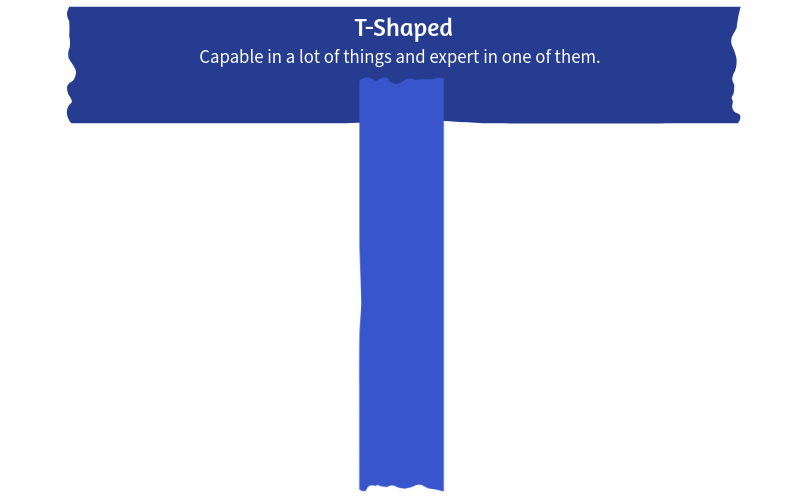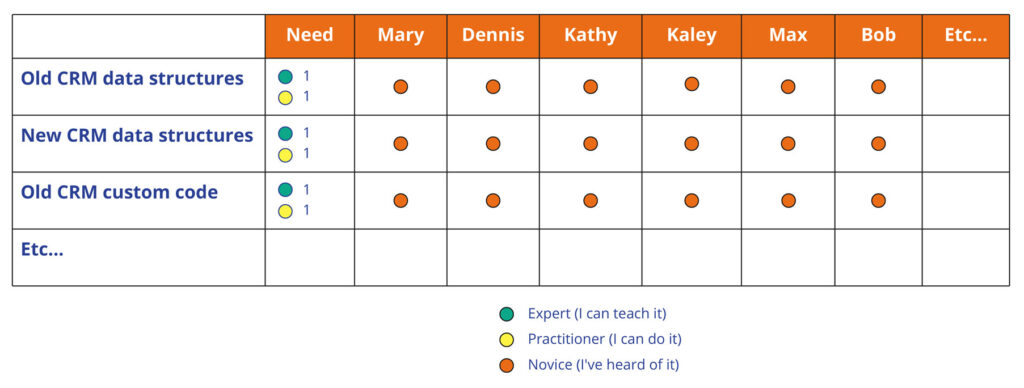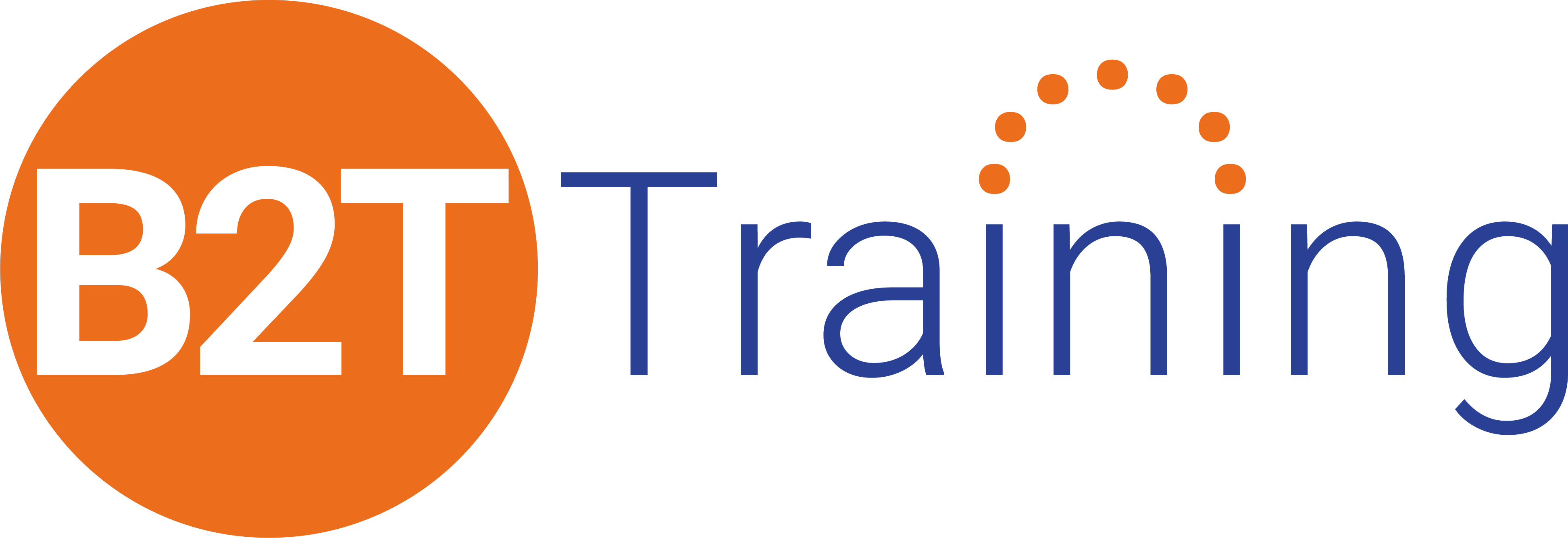What if your next performance review wasn’t written by your manager, but instead by your team? Envision that half of it would come from your peers, and the other half would be based on your team’s results. How would that make you feel? Would you be comfortable, nervous, angry, or somewhere in between?
This question highlights an important concept in agile organizations: success is measured at the team level, not just the individual level. You can be a superstar as an individual, but your overall success is tied to the team’s success. Organizations aren’t interested in debates about whose job or responsibility a task is; they’re interested in outcomes. In other words, agility also applies to individuals: our willingness – and ability – to adapt when the task before our team requires us to step outside our area of expertise.
The Case for T-Shaped Skills
Agile teams are deliberately small—usually five to nine people. For the team to succeed, each member needs more than deep knowledge in a single area; they also need the ability to contribute in other areas when the team needs help. You’ve heard the old saying, “Jack of all trades but master of none?” We need team members to be “Jack of all trades and master of one (or two)”.
That’s the idea behind T-shaped skills. Picture the letter “T”:

- Vertical line: deep expertise in one or two areas
- Horizontal line: the ability to collaborate across disciplines and step in when needed
This is contrasted with someone who has I-shaped skills, possessing depth but no breadth:

Or a generalist who has breadth but no depth:

Without this balance, teams can run into problems. Someone with only breadth may understand a little about many things but be unable to solve complex problems. Someone with only depth in a single area may become a bottleneck, creating a single point of failure. T-shaped skills help team members lean on each other, share the workload, and keep work moving forward.
Developing T-Shaped Growth
On the flip side, it’s not realistic to expect everyone to be a master of every discipline. Not everyone on a team should be able to write and change code. Not everyone is going to be a great facilitator or negotiator. Everyone’s “T” should be customized.
A healthy approach to T-shaped growth might include:
- Deepening your core skill set so you remain valuable in your specialty
- Expanding into one or two adjacent areas where you can support teammates
- Practicing enough to take on small tasks outside your comfort zone
For example, a business analyst might learn basic testing techniques, or a developer might improve communication skills for stakeholder discussions. These small steps add resilience without overwhelming team members.
Our Team Competency Matrix is a great way to visualize any gaps between the skills that a team possess and the skills it needs.

Cross-Training in Practice
Cross-training is one of the most effective ways to build T-shaped skills. When team members step into each other’s roles, even briefly, they gain fresh perspectives and empathy. A developer who shadows a tester for a sprint understands the mindset behind test cases. An analyst who sits with a developer learns what it takes to turn a story into working software.
Some practical exercises include:
- Role rotation during a sprint planning session
- Shadowing another team member for a day
- Pairing across roles, such as an analyst pairing with a tester
These experiences help build confidence, broaden skills, and improve the team’s collective problem-solving abilities. The exercises we’ve created in our Agile Analysis Boot Camp include cross-functional role-playing. Through these simulations, students learn how cross-functional training can be applied to:
- assist team members to help balance the workload,
- appreciate and respect the contributions of the other team members, and
- help with collaboration and decision-making choices that incorporate the various perspectives.
The Payoff
Teams that invest in T-shaped growth are more resilient and collaborative. They’re less likely to burn out because work can shift when someone is overloaded. They also make better decisions, as problems are viewed from multiple perspectives.
Teams that ignore cross-training risk dependency, bottlenecks, and frustration, which quickly lower morale. On the other hand, teams that focus on T-shaped skills improve collaboration, maintain momentum, and sustain high-quality delivery over time.
Shifting the Mindset
If the idea of being reviewed by your peers feels uncomfortable, that’s natural. But it’s also a reminder that your contribution isn’t just what you deliver individually—it’s how you help the team succeed.
Strengthening your “T” benefits both you and your team. It helps your team adapt to challenges, maintain productivity, and sustain motivation. In the end, agile isn’t about individual stars—it’s about a team that can rely on each other and deliver consistently, even under pressure.
So whether you’re a business analyst, tester, developer, or product owner, ask yourself: what’s the next skill I can add to my “T” to make my team stronger?
Best,
K.
Get the rest of the story!
This article is part of a series that we wrote based on challenges we faced during our own CRM conversion project in 2024. Each month we highlight a particular challenge and share tips, techniques, and tools you can use if you find yourself in a similar situation.

Kathy Claycomb
Managing Partner, Lead Expert
Kathy Claycomb brings over 35 years of experience to the classroom. She has participated in all phases of solution development using everything from agile to waterfall methodologies (and quite a few in between). Before joining B2T, her career spanned roles from application developer to Senior Director of Services at various organizations. Kathy has broad industry background including transportation, manufacturing, insurance, energy, healthcare, and banking.
Kathy’s first love is teaching, and throughout her career she has always managed to spend a portion of her time instructing. She has an engaging, highly interactive teaching style that ensures students leave the course with a thorough grasp of the material. Her students consistently praise her teaching abilities and her talent for drawing on her personal experience to enhance their learning.
Kathy served as the Technical Editor for Business Analysis for Dummies, 2nd Edition.

